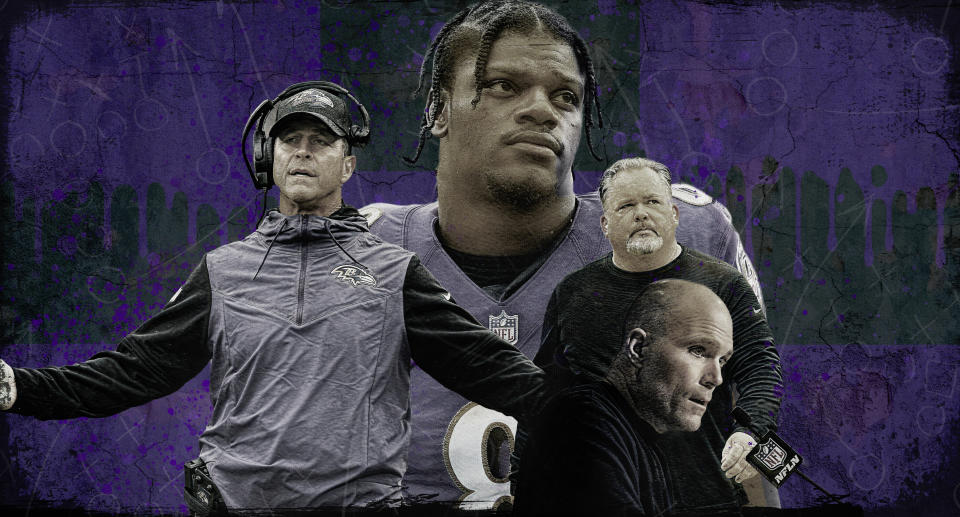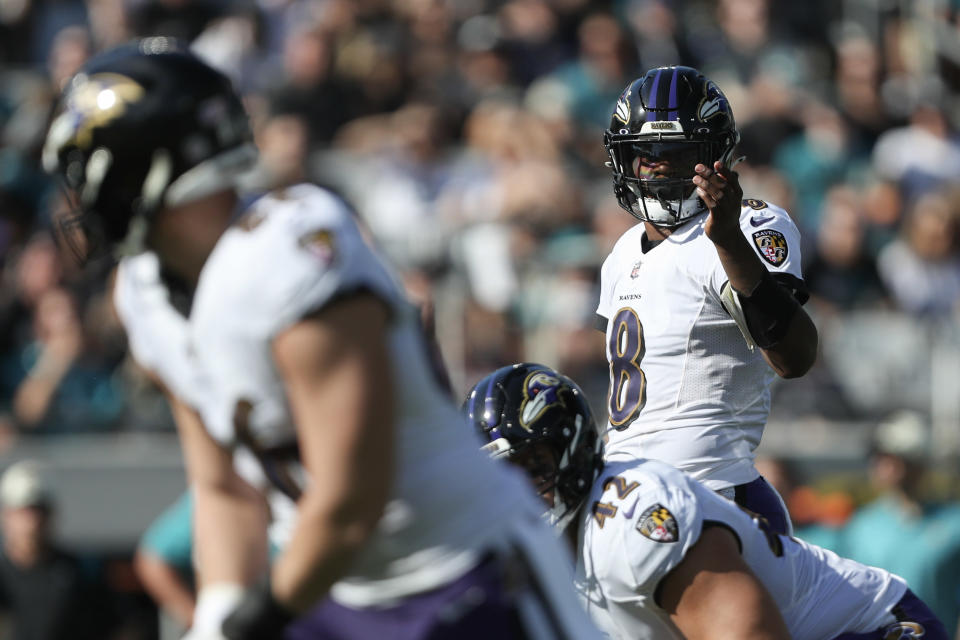The Baltimore Ravens have developed a troubling trend this season: They can’t close out games. This week’s 28-27 defeat at the hands of the Jacksonville Jaguars marked the fourth time this season that the Ravens lost despite having a two-score lead in the second half.
Now, the Ravens still sit atop the AFC North with a 7-4 record and an inside track to the playoffs. But the team’s inability to play up to its potential could ruin a postseason run.
What’s weird is this is an offense that ranks highly in several important metrics. Baltimore is fifth in Football Outsiders’ defense-adjusted value over average, seventh in expected points added per play and eighth in points per game. Yet despite all this, Baltimore ranks 15th in yards per play and 13th in touchdowns scored. They should be much better than that. And at times, they have been: Double-digit wins over the New England Patriots and New Orleans Saints are a testament to the Ravens’ ability.
But Baltimore’s benefited from an easy strength of schedule (tied for 24th heading into the season) and has been buoyed by the second-best rushing offense in the NFL (in DVOA, EPA/play, yards/attempt and yards/game) as well as the league’s best kicker in Justin Tucker. Those three key components have helped fuel their record.
However, when those crutches comes up short — like Tucker’s missed 67-yard field goal at the end of Week 12, or negative-1 rushing yard in the fourth quarter against the Dolphins in Week 2 — the Ravens fall.
Who’s to blame for the Ravens’ losses?


There is a fistful of fingers to point at possible culprits for the Ravens’ struggles, starting with offensive coordinator Greg Roman.
Again, the running game is fine; it’s the passing game that needs work. Simply put, it’s stale. While the Ravens’ overall EPA per play has stayed among the league’s best since Roman joined the team in 2019, the team’s dropback EPA as well as Lamar Jackson’s EPA per play declined since Jackson’s MVP season in 2019.
This year, the Ravens rank 16th in EPA per dropback, and Jackson ranks 12th in EPA per play, below Derek Carr and Justin Fields and slightly above Jacoby Brissett and Daniel Jones. Jackson’s 202.8 passing yards per game ranks 26th in the league, while his 11.2 yards per completion ranks tied for 14th. That’s not good enough to win big in the pass-happy NFL.
The Ravens also aren’t converting drives into touchdowns. Baltimore ranks fourth in total scoring drives (thanks, Tucker), but 25th in touchdown-scoring drives. They’ve reached the red zone the second-most times in the NFL this season, yet score touchdowns on only half their attempts, which ranks 24th.
A lot of this is on Roman’s play calling and scheme, but Jackson isn’t blameless either. His 62.1% completion percentage, 6.9 yards per attempt and 3.9 completed air yards per attempt are is his lowest since his rookie season in 2018. He’s not executing on offense as he did in the past, andwho knows how much the quad injury he reportedly suffered at Wednesday’s practice will affect him.
Jackson is also working with perhaps his worst supporting cast. Ravens pass-catchers have dropped 26 passes this season (tied for third-most) and the 8.5% drop percentage ranks first. This includes three potential touchdowns against the Jaguars, two of which were on drives that ended in field goals. Jackson doesn’t have any reliable receivers outside of tight end Mark Andrews, who himself ranks third in drops this season with five.
The personnel part is mostly an indictment on general manager Eric DeCosta, who failed to bring in any potent offensive talent at the trade deadline or during the offseason. (No, we’re not counting almost 36-year-old DeSean Jackson.) DeCosta used most of the money on safety Marcus Williams, defensive end Calais Campbell and offensive tackle Morgan Moses, all good players in their own right but none who could elevate the offense. DeCosta probably couldn’t have envisioned both second-year wideout Rashod Bateman and third-year running back J.K. Dobbins missing extended time with injury, but the lack of skill position depth is concerning.
What makes it all worse is that DeCosta and Jackson failed to agree on a long-term contract this past offseason. Maybe that’s affected how Jackson’s played — why put yourself at risk without any long-term financial stability? Or maybe, Jackson might develop a wandering eye and see better opportunities elsewhere on teams with more promise. Plenty of franchises would jump at the chance to sign Jackson if he ever hit the open market. That potential problem is also on DeCosta.
Baltimore’s defense also at fault
Some blame lies on the other side of the ball, too. A team is only as good as its ability to stop the opposition from scoring, and the Ravens have been bad at that, especially in the second half.


Baltimore ranks 27th in EPA/play allowed in the second half, which is only slightly better than the Atlanta Falcons. A lot of that is on the pass defense specifically, which gives up the sixth-most yards per game and also ranks 27th in dropback EPA/play allowed in the second half.
This is despite the aforementioned additions of Williams and Campbell, as well the selection of safety Kyle Hamilton in the first round of the 2022 draft and the trade deadline acquisition of pass rusher Roquan Smith.
Ravens are still in good shape
Hope is not lost in Baltimore. The Ravens have the second-easiest strength of schedule remaining and have proven they can score in bunches at times. They have a 90 percent chance to make the playoffs and a 69 percent chance to win the division, per FiveThirtyEight.
But when the playoffs hit, adjustments must be made across the board. Roman needs to figure out how to capture Jackson’s dynamism again. (Or take the Stanford job after the season.) Jackson needs to be more accurate. The Ravens’ pass-catchers must hold onto the ball. And the defense can’t keep blowing leads.
None of these are simple fixes, but if the Ravens want to be legitimate contenders, they’ll need to shore up their issues over the final six weeks of the season. Baltimore hasn’t locked the division yet, and the Cincinnati Bengals could make another late-season push as they did during their Super Bowl run in 2021.
